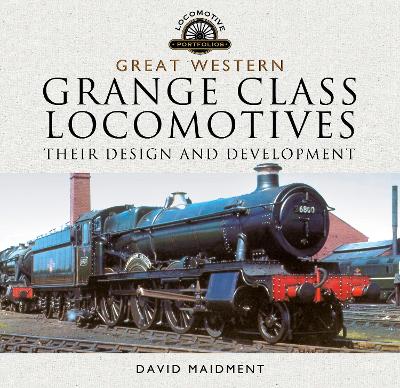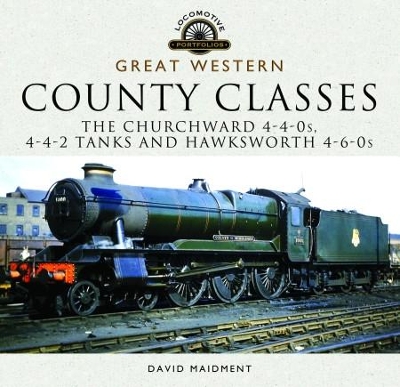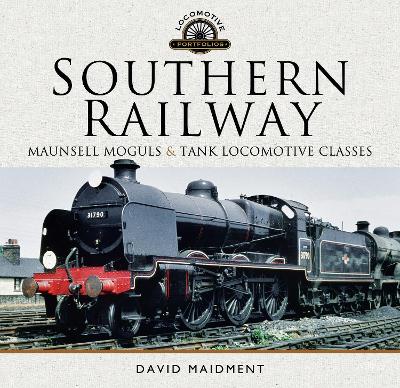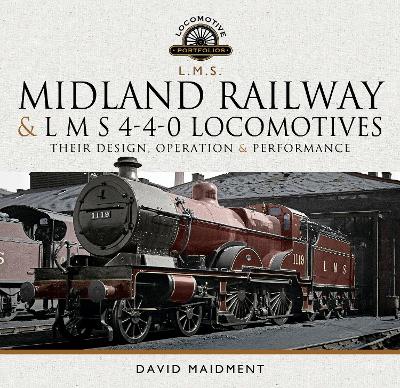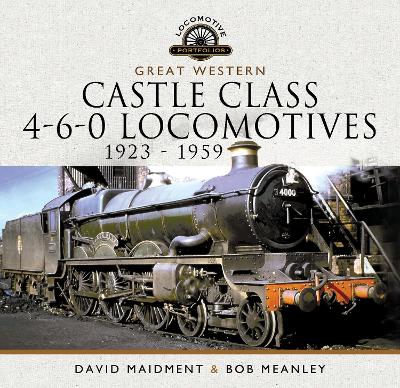Locomotive Portfolio
6 total works
Churchward proposed a 5ft 8in wheeled 4-6-0 for mixed traffic duties in 1901 and it was seriously considered in 1905, but it took until 1936 before his successor, Charles Collett, realised the plan by persuading the GWR Board to replace many of the 43XX moguls with modern standard mixed traffic engines that bore a remarkable likeness to the Churchward proposal. David Maidment has written another in his series of Locomotive Portfolios' for Pen & Sword to coincide with the construction of a new Grange' at Llangollen from GW standard parts to fill the gap left by the total withdrawal and scrapping of one of that railway's most popular classes - to their crews at the very least. As well as covering the type's design and construction, the author deals comprehensively with the allocation and operation of the eighty locomotives and in particular has researched their performance and illustrated it with many examples of recorded logs from the 1930s as well as in more recent times. As in previous volumes, the author has added his own personal experiences with the engines and has sourced more than 250 photos, over 40 of which are in colour.
Southern, Two and Three Cylinder 4-4-0 Classes (L, D1, E1, L1 and V)
by Maidment, David
Published 16 April 2019
This book is one of the Pen & Sword Locomotive Portfolio series and covers the rebuilding by Richard Maunsell of the South Eastern & Chatham Railway 'D' and 'E' 4-4-0s as 'D1' and 'E1' locomotives with higher pressure boilers and long-travel valve events following the Churchward principles. The book also covers the SE&CR 'L' class designed by Maunsell's predecessor, Harry Wainwright, with modifications made by Maunsell just before their delivery in 1914\. Maunsell then designed a further 2 cylinder 4-4-0, the 'L1' for the Victoria - Folkestone 80-minute expresses of the mid-1920s and finally the 3-cylinder 'V' (the 'Schools' class), his masterpiece, for express services on all three constituent parts of the Southern Railway.
Design, construction, operations and performance of these locomotives are described and profusely illustrated with over 300 black & white and colour photos from their construction right through to their final demise in 1962, together with an update on the three 'Schools' that have been preserved and operate on Britain's heritage steam railways.
Design, construction, operations and performance of these locomotives are described and profusely illustrated with over 300 black & white and colour photos from their construction right through to their final demise in 1962, together with an update on the three 'Schools' that have been preserved and operate on Britain's heritage steam railways.
The Great Western Railway, had two classes of tender locomotives named after counties, the first class of two cylinder 4-4-0 tender locomotives, designed by George Jackson Churchward, were introduced in the 1900s to provide efficient motive power, for express passenger services on lines in the North Western area, of what was the Great Western, which were jointly operated, with the L & N W R from Shrewsbury to Birkenhead Woodside.
The 4-4-0 counties were in service on top link services until the early 1930s, when they were withdrawn and replaced by more modern motive power.
The 4-4-0 counties, were paralleled in design by the county 4-4-2 tanks, which operated suburban services in the London area and were also withdrawn in the early 1930s.
In 1945, the Great Western Introduced the County 4-6-0 tender locomotives, designed by F W Hawksworth, these two cylinder machines had a high pressure boiler, that was meant to give the same tractive effort as a Castle class, 4-6-0, four cylinder locomotive,
After modifications and boiler pressure reduction, the County class 4-6-0s, operated in express and semi fast train service, until the last members of the class were withdrawn in 1964.
The 4-4-0 counties were in service on top link services until the early 1930s, when they were withdrawn and replaced by more modern motive power.
The 4-4-0 counties, were paralleled in design by the county 4-4-2 tanks, which operated suburban services in the London area and were also withdrawn in the early 1930s.
In 1945, the Great Western Introduced the County 4-6-0 tender locomotives, designed by F W Hawksworth, these two cylinder machines had a high pressure boiler, that was meant to give the same tractive effort as a Castle class, 4-6-0, four cylinder locomotive,
After modifications and boiler pressure reduction, the County class 4-6-0s, operated in express and semi fast train service, until the last members of the class were withdrawn in 1964.
Southern Railway, Maunsell Moguls and Tank Locomotive Classes
by Maidment, David
Published 29 October 2018
Southern Maunsell Moguls and Tank Engines is a volume in the series of Locomotive Profiles being published by Pen & Sword. It describes the conception, design and construction of the two- and three-cylinder 2-6-0s initially the 'Ns' constructed at the end of the First World War, many at government initiative by the Woolwich Arsenal and their three-cylinder variants, the 'N1s'. It also describes in similar fashion the class 'K' River 2-6-4 tank engines, their riding problems and the decision to convert them as class 'U' two-cylinder moguls after the disastrous Sevenoaks derailment in 1927\. The solitary 'K1' three-cylinder 2-6-4T was similarly converted as the prototype three-cylinder 'U1' with new build 'Us' and 'U1s' following in the early 1930s.
The moguls, originally built by Richard Maunsell for the South Eastern & Chatham Railway, became the standard mixed traffic locomotives throughout the Southern Railway for virtually the whole of its existence and many remained until near the end of BR Southern Region's steam stock in 1965/6.
After the experience with the passenger 2-6-4 tank engines, Maunsell restricted his larger tank engine designs to freight work - the class 'W' for heavy cross-London interchange freight traffic and the 'Z'0-8-0T for heavy shunting and banking work. Maunsell also redesigned some elderly LB&SCR E1 0-6-0Ts for branch line work in rural Devon and North Cornwall, providing a radial axle as 0-6-2T class E1/R.
The book covers the allocation, operation and performance of these classes and includes some personal reminiscences of the author who experienced the moguls at first hand. It also covers the sale of some of the Woolwich moguls to the CIE in Ireland and the conversion of a number to 2-6-4 freight tank engines for the Metropolitan Railway. The book is lavishly illustrated with over 300 black and white and thirty colour photographs.
The moguls, originally built by Richard Maunsell for the South Eastern & Chatham Railway, became the standard mixed traffic locomotives throughout the Southern Railway for virtually the whole of its existence and many remained until near the end of BR Southern Region's steam stock in 1965/6.
After the experience with the passenger 2-6-4 tank engines, Maunsell restricted his larger tank engine designs to freight work - the class 'W' for heavy cross-London interchange freight traffic and the 'Z'0-8-0T for heavy shunting and banking work. Maunsell also redesigned some elderly LB&SCR E1 0-6-0Ts for branch line work in rural Devon and North Cornwall, providing a radial axle as 0-6-2T class E1/R.
The book covers the allocation, operation and performance of these classes and includes some personal reminiscences of the author who experienced the moguls at first hand. It also covers the sale of some of the Woolwich moguls to the CIE in Ireland and the conversion of a number to 2-6-4 freight tank engines for the Metropolitan Railway. The book is lavishly illustrated with over 300 black and white and thirty colour photographs.
David Maidment has unravelled the complex history of the Johnson, Deeley and Fowler 4-4-0 locomotives of the Midland Railway and its LMS successor, covering their design, construction, operation and performance in this book with over 400 black and white photographs. It recounts their working on the Midland main lines from St Pancras to Derby, Manchester, Leeds and Carlisle, the latter via the celebrated Settle & Carlisle line, and the later work of the Fowler LMS engines on the West Coast main line. The book also describes the history of the Midland 4-4-0s built for the Somerset & Dorset and Midland & Great Northern Railways. The book covers the period from the first Midland 4-4-0 built in 1876 to the last LMS 2P withdrawn in 1962 and includes performance logs, weight diagrams and dimensions and statistical details of each locomotive.
Great Western Castle Class 4-6-0 Locomotives 1923 - 1959
by Maidment, David and Meanley, Bob
Published 30 October 2022
The Great Western Castles were one of the most successful locomotive designs of the twentieth century in terms of both performance and efficiency. Designed by Charles Collett in 1923, based on the 1907 Churchward Star' class, 155 were constructed almost continuously, apart from the war years, between 1923 and 1950, in addition to fifteen rebuilt Stars' and one rebuilt from the Great Bear pacific. Many were modernised with increased superheat and double-chimneys in the late 1950s and the class continued to be the mainstay of all Western Region express passenger services to the West Country, South Wales, Gloucestershire, Herefordshire and the West Midlands until replaced by the WR diesel hydraulic fleet in the early 1960s. This book covers their design in a chapter written by Bob Meanley, who masterminded the restoration at Tyseley Works of the Castles Earl of Mount Edgcumbe and Clun Castle, and their history, operation and performance from the high speed of the 1930s through to their rejuvenation in the 1950s, leaving experience of their last years and preservation to another volume. David Maidment had close experience of the class when working at Old Oak Common between 1957 and 1962 and includes his personal experiences there and on the road from his first encounter with one as a six-year old boy. The book includes 350 photographs, some 40 in colour, and 23 detailed Swindon technical drawings.
